Now in its 56th year, Wildlife Photographer of the Year is the London Natural History Museum’s showcase for the world’s best nature photography. This year’s competition attracted over 49,000 entries from professionals and amateurs across 86 countries. Here are seven images from Chinese photographers that made the grade, including three from underwater photographer Songda Cai.
When Mother Says Run, Shanyuan Li

Winner
Category: Behavior: Mammals
This rare picture of a family of Pallas’s cats, or manuls, on the remote steppes of the Qinghai-Tibet Plateau in northwest China is the result of six years’ work at high altitude. These small cats are normally solitary, hard to find and mostly active at dawn and dusk.
Through long-term observation, Shanyuan knew his best chance to photograph them in daylight would be in August and September, when the kittens were a few months old and the mothers bolder and intent on caring for them.
He tracked the family as they descended to about 3,800 meters (12,500 feet) in search of their favorite food – pikas (small, rabbit‑like mammals) – and set up his hide on the hill opposite their lair, an old marmot hole. Hours of patience were rewarded when the three kittens came out to play, while their mother kept her eye on a Tibetan fox lurking nearby.
Their broad, flat heads – with small, low‑set ears – together with their color and markings, help them stay hidden when hunting in open country, and their thick coats keep them alive in the extreme winters.
In the clear air, against a soft background, Shanyuan caught their expressions in a rarely seen moment of family life, when their mother had issued a warning to hurry back to the safety of the lair.
Their real threat, though, is not foxes but the degradation and fragmentation of their steppe grassland – throughout their Central Asian range – caused by overgrazing, arable conversion, mining and general human disturbance, alongside poisoning of their prey and hunting, for their fur and as pets.
The Golden Moment, Songda Cai
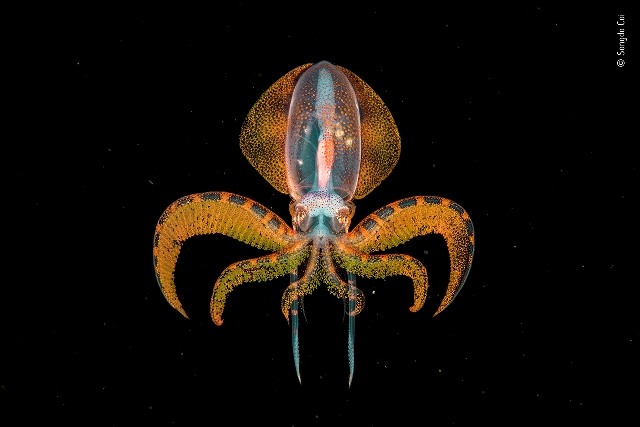
Winner
Category: Underwater
A tiny diamondback squid paralarva flits below in the blackness, stops hunting for an instant when caught in the light beam, gilds itself in shimmering gold and then moves gracefully out of the light. The beam was Songda’s, on a night‑dive over deep water, far off the coast of Anilao, in the Philippines.
He never knows what he might encounter in this dark, silent world. All sorts of larvae and other tiny animals – zooplankton – migrate up from the depths under cover of night to feed on surface-dwelling phytoplankton, and after them come other predators.
Diamondback squid are widespread in tropical and subtropical oceans, preying on fish, other squid and crustaceans near the surface. In November, hundreds gather off Anilao to spawn.
A paralarva is the stage between hatchling and subadult, already recognizable as a squid, here 6-7 centimeters long (21/2 inches). Transparent in all stages, a diamondback squid swims slowly, propelled by undulations of its triangular fins (the origin of their name), but by contracting its powerful mantles, it can spurt away from danger.
Chromatophores (organs just below the skin) contain elastic sacs of pigment that stretch rapidly into discs of color when the muscles around them contract; recent research suggests that they may also reflect light. Deeper in the skin, iridophores reflect and scatter light, adding an iridescent sheen.
From above, Songda captured the fleeting moment when, hovering in perfect symmetry, the diamondback paralarva turned to gold.
Jelly Nanny by Songda Cai
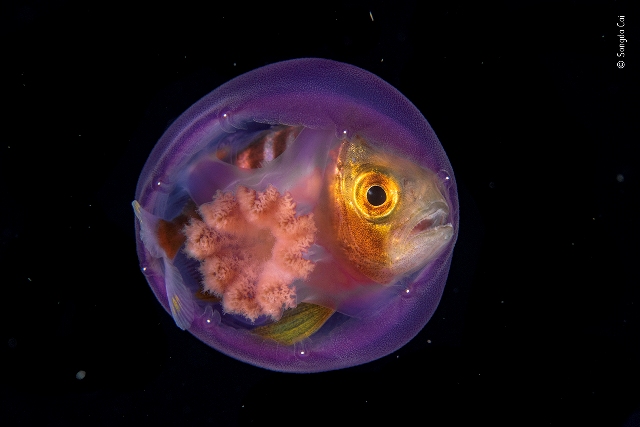
Highly Commended
Category: Underwater
A young trevally stares out from inside a small jellyfish. Its expression may seem forlorn, but, the little fish is exactly where it wants to be. It swam under the jelly’s umbrella (dodging or possibly immune to its stings) to seek refuge from predators deterred by the jelly’s weapons.
Shelter is hard to come by in open water, and the young of at least 80 species of fish turn to jellyfish for protection. The jellies don’t appear to suffer harm or benefit from their passengers (apart from occasionally eating them), but if water becomes more acidic (as predicted with climate change) this relationship breaks down. The fish are less attracted to their hosts, possibly because their senses are impaired, and so are more exposed to predation.
Songda spotted this couple while night-diving far off the coast of Anilao, in the Philippines, and captured their vibrant colors against the darkness.
Speeding Squid, Songda Cai
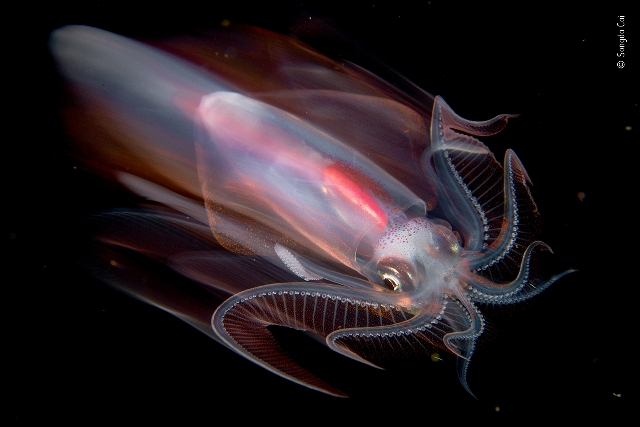
Highly Commended
Category: Underwater
Songda spotted this 8-centimeter-long (3-inch) diamondback squid paralarva on a night dive off Anilao, in the Philippines. Normally a slow mover, it can put on a burst of speed by high-pressure jet-propulsion, forcing water out through a funnel by contracting its mantle. It can direct the force by moving the funnel, accelerating forward to grab prey and backward to escape predators.
It is also one of the fastest‑growing squids: newly hatched larvae are little more than a millimeter long but reach a mantle length of more than 70 centimeters (28 inches) within 300 days.
Songda used a long exposure to catch the sense of motion. He artfully combined this with lighting to reveal the larva’s head and membranous fringes of its suckered arms, allowing the little squid to paint its path across the frame.
High-Altitude Pursuit, Haiyuan Tong

Highly Commended
Category: Behavior: Mammals
In the final leg of a long hunt, a Himalayan wolf closes in on a young Tibetan gazelle.
It was late afternoon in early winter when Haiyuan first spotted the small pack of wolves. Heavy snow in the Kunlun Mountains of China’s Qinghai-Tibet Plateau had driven them down to a lower altitude than usual (just over 4,000 meters – 13,000 feet) in search of food. As they approached a herd of Tibetan gazelles, they split up and began to encircle their prey, slowly drawing nearer.
These wolves – now proposed as a distinct subspecies of the greywolf and possibly a full species – are uniquely adapted to survive in these harsh high altitudes. Suddenly, they launched their attack. But the gazelles scattered.
Haiyuan tracked the pack for the next two hours, himself challenged by the altitude and severe cold, while the wolves tried again and again to pick off a gazelle.
It was almost dark, when the pack (and Haiyuan) finally got what they were after. Panicked, a young gazelle started running away from the herd. Now, it was a straight chase, the wolves taking it in turns to pursue their quarry, until they had run it down.
Haiyuan’s picture captures the wolf’s determination – eyes locked on to their target – and the frightened young gazelle, running for its life.
Life in the Coral Corridors, Weiwei Zeng
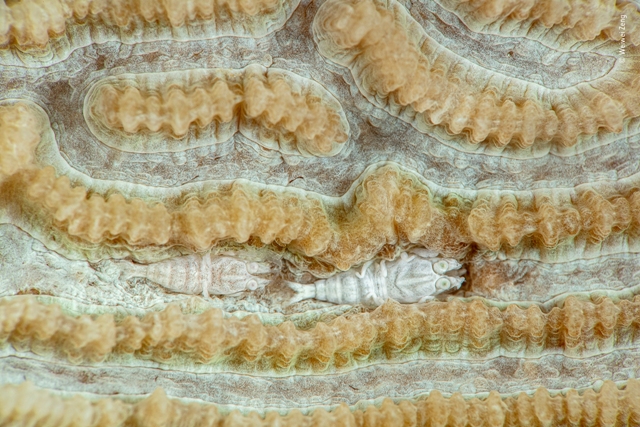
Highly Commended
Category: Animals in their Environment
Diving off the remote island of Romblon, in the Philippines, eagle-eyed Weiwei spotted two tiny shrimps –just 5 millimeters (1/5 inch)long – nose-to-tail between the folds of tissue on a large, round brain coral.
These pale-colored palaemonid shrimps live on hard, or stony, corals, sneaking along the tight passages between the coral’s septa (here with their rows of tiny polyps closed up, feeding tentacles retracted for the day), but doing their host no harm.
Hard corals are the main reef-builders – individual soft-bodied polyps produce rigid skeletons of calcium carbonate for protection, and in colonial species such as brain coral, vast numbers of these become fused. They also provide shelter and food for a great diversity of other animals.
These particular shrimps, as well as sporting stony colors that blend in superbly, have evolved a remarkable way of hiding – they hook the soft tissues of the coral on either side with their legs and draw it in over their backs like curtains.
Weiwei began to shoot the shrimps close up but decided that their environment had to be part of the picture. Fighting to keep still in the current, she framed the ridged maze of brain coral with its shrimps, in single file, fitting perfectly into their surroundings.
Spoon-feeding, Lefei Han
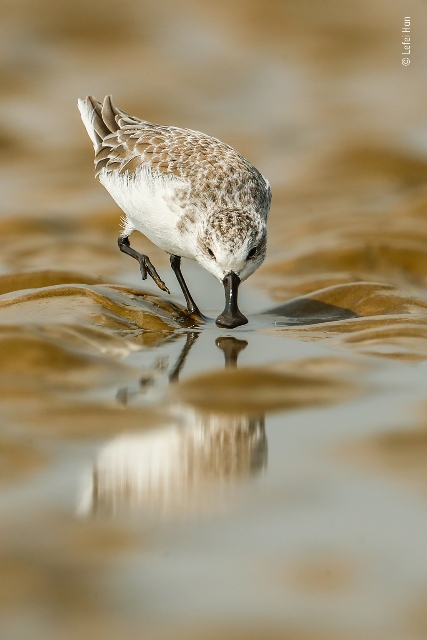
Highly Commended
Category: 15-17 Years Old
A spoon-billed sandpiper scoops with its unique bill as it searches for marine invertebrates on the Tiaozini mudflats in Jiangsu, China.
Lefei had to move slowly and carefully over the mudflats and eventually crawl to get close enough and low enough to capture this portrait of one of the most endangered birds in the world. There are now no more than about 200 pairs remaining. Their numbers plummeted possibly 80% in the first decade of this century, sparking an international effort to prevent their extinction.
Spoon-billed sandpipers depend on intertidal habitats such as China’s mudflats as vital ‘stopovers’ during their long‑distance migration between breeding grounds on the Russian tundra and wintering sites across Southeast Asia. Along this great journey they are threatened by the destruction through coastal development of feeding and roosting grounds, particularly in China and South Korea, and by subsistence hunting in Myanmar, where half the population winters.
Photographing a spoon‑billed sandpiper is a challenge as not only are they very rare, they feed in mixed flocks with other small waders and can be frustratingly difficult to spot. It took Lefei an hour to locate one. Having mounted a tripod head to his old surfboard, he was able to angle his camera at ground level to get the perfect shot. Through the viewfinder, he watched as the little wader swayed its beak from side to side, perfectly poised, ‘ready to scoop with its spoon’.
And Last Year...
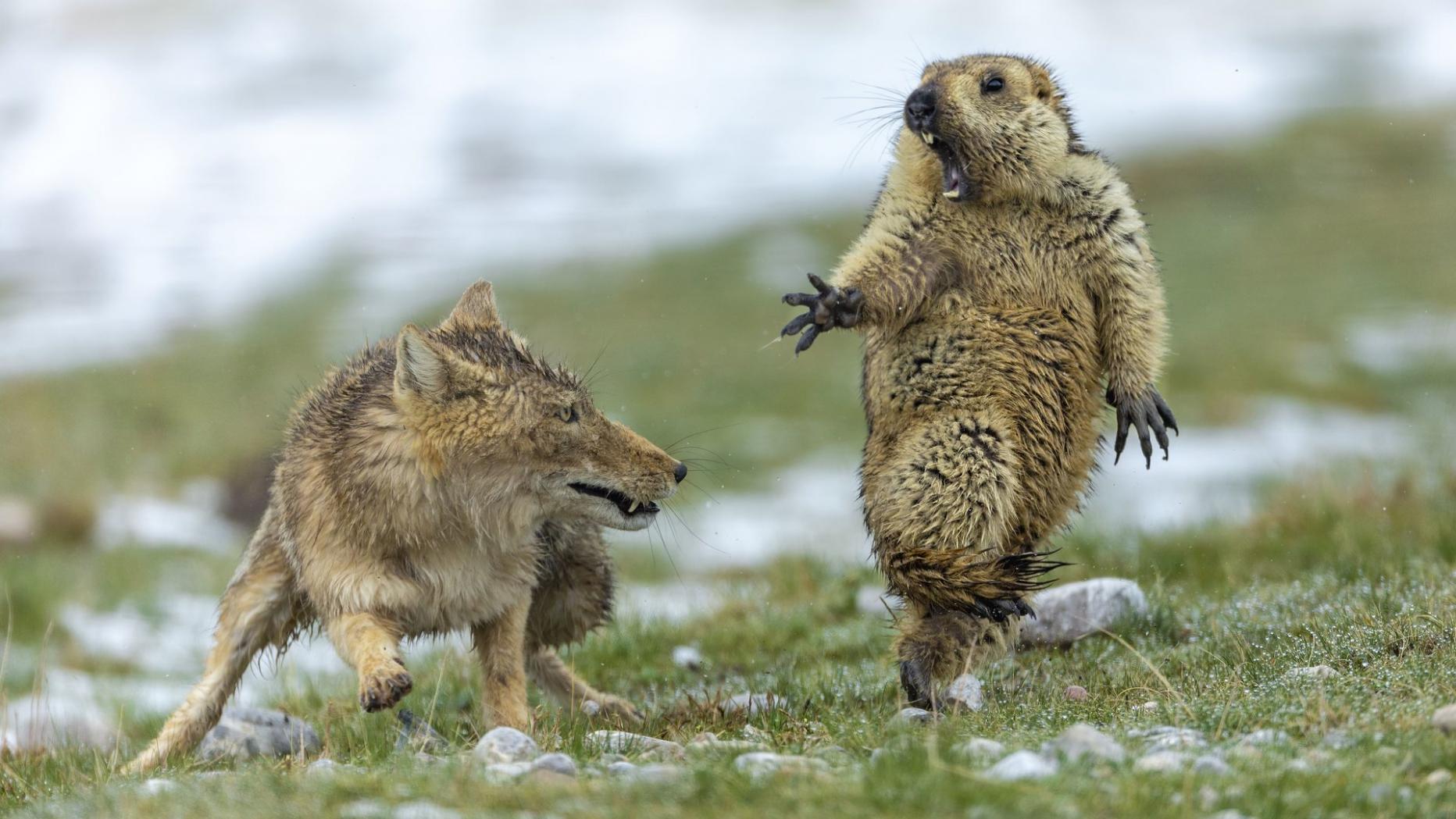
Who could forget this Grand Title Winner for Wildlife Photographer of the Year 2019, ‘The Moment’ by Yongqing Bao?
This Himalayan marmot was not long out of hibernation when it was surprised by a mother Tibetan fox with three hungry cubs to feed. With lightning-fast reactions, Yongqing captured the attack – the power of the predator baring her teeth, the terror of her prey, the intensity of life and death written on their faces.
As one of the highest-altitude-dwelling mammals, the Himalayan marmot relies on its thick fur for survival through the extreme cold. In the heart of winter it spends more than six months in an exceptionally deep burrow with the rest of its colony. Marmots usually do not resurface until spring, an opportunity not to be missed by hungry predators.
For more Chinese Wildlife Photographer of the Year 2019 Winners, click here.
[All images courtesy of Wildlife Photographer of the Year]





















0 User Comments